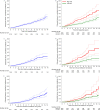Colorectal cancer risk following polypectomy in a multicentre, retrospective, cohort study: an evaluation of the 2020 UK post-polypectomy surveillance guidelines
- PMID: 33674342
- PMCID: PMC8588296
- DOI: 10.1136/gutjnl-2020-323411
Colorectal cancer risk following polypectomy in a multicentre, retrospective, cohort study: an evaluation of the 2020 UK post-polypectomy surveillance guidelines
Abstract
Objective: Colonoscopy surveillance aims to reduce colorectal cancer (CRC) incidence after polypectomy. The 2020 UK guidelines recommend surveillance at 3 years for 'high-risk' patients with ≥2 premalignant polyps (PMPs), of which ≥1 is 'advanced' (serrated polyp (or adenoma) ≥10 mm or with (high-grade) dysplasia); ≥5 PMPs; or ≥1 non-pedunculated polyp ≥20 mm; 'low-risk' patients without these findings are instead encouraged to participate in population-based CRC screening. We examined the appropriateness of these risk classification criteria and recommendations.
Design: Retrospective analysis of patients who underwent colonoscopy and polypectomy mostly between 2000 and 2010 at 17 UK hospitals, followed-up through 2017. We examined CRC incidence by baseline characteristics, risk group and number of surveillance visits using Cox regression, and compared incidence with that in the general population using standardised incidence ratios (SIRs).
Results: Among 21 318 patients, 368 CRCs occurred during follow-up (median: 10.1 years). Baseline CRC risk factors included age ≥55 years, ≥2 PMPs, adenomas with tubulovillous/villous/unknown histology or high-grade dysplasia, proximal polyps and a baseline visit spanning 2-90 days. Compared with the general population, CRC incidence without surveillance was higher among those with adenomas with high-grade dysplasia (SIR 1.74, 95% CI 1.21 to 2.42) or ≥2 PMPs, of which ≥1 was advanced (1.39, 1.09 to 1.75). For low-risk (71%) and high-risk (29%) patients, SIRs without surveillance were 0.75 (95% CI 0.63 to 0.88) and 1.30 (1.03 to 1.62), respectively; for high-risk patients after first surveillance, the SIR was 1.22 (0.91 to 1.60).
Conclusion: These guidelines accurately classify post-polypectomy patients into those at high risk, for whom one surveillance colonoscopy appears appropriate, and those at low risk who can be managed by non-invasive screening.
Keywords: colonoscopy; colorectal adenomas; colorectal cancer; colorectal cancer screening; surveillance.
© Author(s) (or their employer(s)) 2021. Re-use permitted under CC BY. Published by BMJ.
Conflict of interest statement
Competing interests: AJC, as Chief Investigator, was the recipient of all the funding. MDR reports personal fees from Swiss SCWeb AG, Pentax, and Norgine, and a grant from Olympus, outside the submitted work.
Figures


Similar articles
-
Long-term Risk of Colorectal Cancer After Removal of Conventional Adenomas and Serrated Polyps.Gastroenterology. 2020 Mar;158(4):852-861.e4. doi: 10.1053/j.gastro.2019.06.039. Epub 2019 Jul 11. Gastroenterology. 2020. PMID: 31302144 Free PMC article.
-
Adenoma surveillance and colorectal cancer incidence: a retrospective, multicentre, cohort study.Lancet Oncol. 2017 Jun;18(6):823-834. doi: 10.1016/S1470-2045(17)30187-0. Epub 2017 Apr 28. Lancet Oncol. 2017. PMID: 28457708 Free PMC article.
-
Colorectal cancer incidence after the first surveillance colonoscopy and the need for ongoing surveillance: a retrospective, cohort analysis.Gut. 2025 Aug 7;74(9):1419-1429. doi: 10.1136/gutjnl-2024-334242. Gut. 2025. PMID: 40187891
-
[Korean Guidelines for Postpolypectomy Colonoscopic Surveillance: 2022 Revised Edition].Korean J Gastroenterol. 2022 Sep 25;80(3):115-134. doi: 10.4166/kjg.2022.103. Korean J Gastroenterol. 2022. PMID: 36156035 Review. Korean.
-
Surveillance after colorectal polyp resection.Best Pract Res Clin Gastroenterol. 2023 Oct;66:101848. doi: 10.1016/j.bpg.2023.101848. Epub 2023 Jul 5. Best Pract Res Clin Gastroenterol. 2023. PMID: 37852710 Review.
Cited by
-
Chronic Kidney Disease Increases Risk of Delayed Post-Polypectomy Bleeding: A Large-Scale Propensity Score-Matched Analysis.United European Gastroenterol J. 2025 Jun;13(5):759-772. doi: 10.1002/ueg2.70013. Epub 2025 Mar 20. United European Gastroenterol J. 2025. PMID: 40111850 Free PMC article.
-
Use of surveillance colonoscopy among individuals with removal of high-risk polyps according to the US Multi-Society Task Force recommendations.Cancer. 2023 May 1;129(9):1394-1401. doi: 10.1002/cncr.34692. Epub 2023 Feb 17. Cancer. 2023. PMID: 36807015 Free PMC article.
-
Risk stratification for the detection of metachronous polyps after bowel screening polypectomy: clinical outcomes from the Integrated Technologies for Improved Polyp Surveillance (INCISE) study cohort.BJS Open. 2023 May 5;7(3):zrad034. doi: 10.1093/bjsopen/zrad034. BJS Open. 2023. PMID: 37158435 Free PMC article.
-
Systematic Evaluation of Clinical, Nutritional, and Fecal Microbial Factors for Their Association With Colorectal Polyps.Clin Transl Gastroenterol. 2024 Feb 1;15(2):e00660. doi: 10.14309/ctg.0000000000000660. Clin Transl Gastroenterol. 2024. PMID: 38088370 Free PMC article.
-
Risk factors of post-polypectomy bleeding and recurrence in children with colorectal polyps after endoscopic mucosal resection: a retrospective cohort study.Transl Pediatr. 2022 Nov;11(11):1823-1830. doi: 10.21037/tp-22-518. Transl Pediatr. 2022. PMID: 36506768 Free PMC article.
References
Publication types
MeSH terms
Grants and funding
LinkOut - more resources
Full Text Sources
Other Literature Sources
Medical
